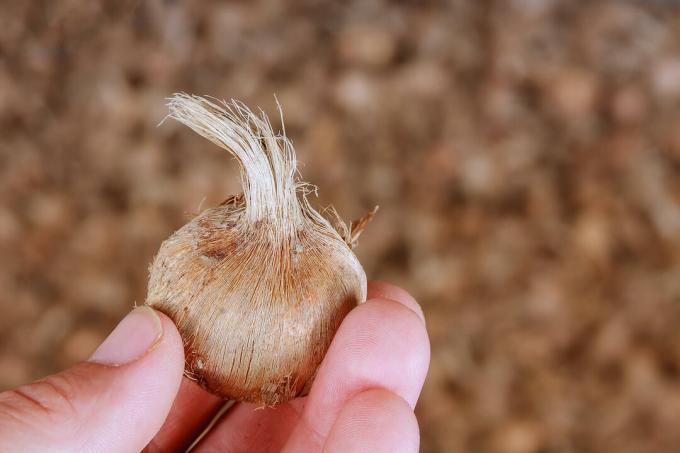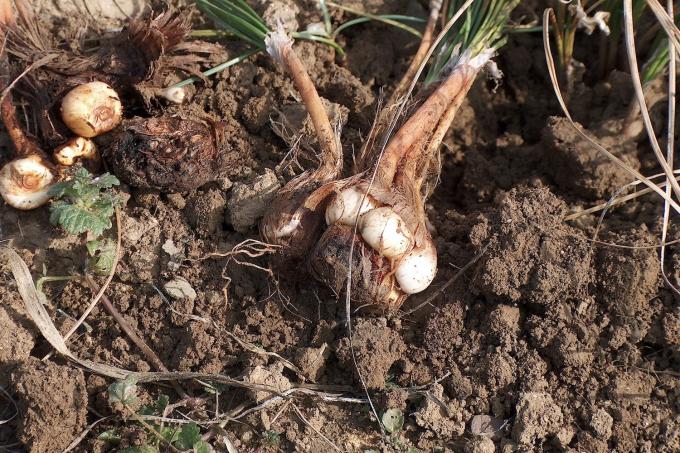It is the most expensive spice in the world - saffron. We will show you whether and how you can grow this extraordinary spice in your own garden.

With saffron (Crocus sativus) dishes are not only seasoned, but also refined. A single gram of the valuable spice costs 10 to 20 euros, depending on the quality. The autumn crocus also thrives in our latitudes, even if it cannot be harvested often. We give tips on planting, caring for and using the saffron crocus.
contents
- Saffron crocus: origin and characteristics
-
Growing saffron
- The right location for saffron
- Plant saffron
- Caring for the saffron crocus
- Propagate saffron
- Hibernate saffron crocus
- Saffron as a Spice: Use and Ingredients
Saffron crocus: origin and characteristics
The perennial saffron crocus from the iridaceae family has its origin in the Aegean Sea. It is mainly grown in warm Mediterranean regions and the Middle East. Saffron is from a mutation of the related crocus species by chance
Crocus cartwrightianus developed. On the one hand, larger flowers developed, on the other hand, significantly longer and larger stylus threads on which the stigmas are located. It is precisely these characteristic, long, deep red saffron threads that are relevant for saffron cultivation. They contain the slightly bitter, spicy saffron aroma and the strong coloring power. These saffron threads form during the flowering of the purple autumn crocus in October to November. However, the sensitive stylus cannot tolerate temperatures below 15 ° C, and so the saffron spice can actually only be harvested in very mild wine-growing regions. In all other areas, however, the planting of saffron is worthwhile simply because of its ornamental value, the low maintenance and the late blooming time, which reminds us of the past crocus bloom in spring.
Growing saffron
The cultivation of the precious saffron plant is not that easy, because it places high demands on its location. The cultivation of the expensive spice can, in individual cases, also be successful in sheltered and warm locations in our home gardens. In order to be able to harvest a considerable amount at all, however, around 150 flowers would have to be grown for 1 g of dried saffron threads.
The right location for saffron
Saffron plants prefer dry, sunny locations on loose, sandy and calcareous soils. Waterlogging must be avoided at all costs, because otherwise the tubers and roots rot quickly in the earth. Whether in a pot or in a bed, the saffron crocus prefers to be sheltered from the wind and warm. This increases the chance of being able to harvest the stylus threads in autumn. For this purpose, the autumn crocus needs constant temperatures of around 15 ° C during flower formation, even in September and October.
Plant saffron
Saffron is only propagated vegetatively, so you plant small saffron tubers directly in the ground. The small tubers can be planted directly in the ground or in a pot from July to the end of August. For the cultivation of saffron in the pot, the planter should be sufficiently large, this makes fertilization easier later. The pot should hold at least 10 liters for a single tuber that also multiplies underground in late autumn and forms daughter tubers. A nutrient-rich potting soil is particularly recommended for potting. Instead of climate-damaging peat, we recommend a soil with a high compost content, which stores moisture and provides nutrients over the long term. The potting soil should be enriched to at least 30% with sand, perlite, lava fragments or coarse broken bricks. A drainage layer of at least ¼ the height of the pot should be filled in at the bottom of the pot. Broken bricks, expanded clay or pebbles, for example, are suitable for this.

The saffron tubers are placed at a depth of 15 cm, the plant tubers should be about 15 cm apart. To protect the tubers from voles, a vole basket can also be used when planting.
Caring for the saffron crocus
After planting, the saffron does not need any irrigation at first, because the tubers contain enough water for root formation and budding. In the further culture, occasional watering in extreme heat and drought in late summer September is completely sufficient to supply the tuber for the energy-sapping flower formation. In the rest period from May to August, the saffron should not be watered at all, because it now has neither leaves nor flowers.
If saffron is grown in pots, an annual dose of mainly organic long-term fertilizer, like ours, provides Plantura organic flower fertilizer, the necessary nutrients for a beautiful bloom and strong green leaves. The fertilizer can either be introduced each spring when repotting or simply worked flat into the surface of the potting soil with a fork. Even when growing in natural soil, some organic fertilizer can be buried under in spring.
It is advisable to repot the saffron every 3 to 5 years or to plant it in a different location. The digging and moving should be done during the resting period from April to September. The chive-like leaves remain in place in winter and, depending on the temperature and weather, do not move in until April.
Tip: The saffron plant is perennial and, with good care, will delight you for many years. However, it is also self-intolerant. There should be a 10-year break in cultivation in the same area before new saffron is planted.
Propagate saffron
The approximately 10 to 15 cm high iris family has a triple set of chromosomes due to its unusual genetic origin. It is therefore sterile and cannot produce germinable seeds. Saffron cannot therefore be propagated through seeds because there are no saffron seeds. The only possibility of propagation is via daughter tubers. After the saffron bloom in late autumn, the crocus forms vegetatively small tubers that have exactly the same genetic material, i.e. they are natural clones of the mother plant. They can be dug up after the death of the foliage in April and repositioned one by one. If the conditions are good, the number of daughter tubers doubles every year and so the saffron can be reproduced quickly.
Hibernate saffron crocus
The relatively hardy saffron crocus tolerates temperatures down to -10 ° C in the soil, at lower temperatures it becomes critical. A cover made of fir branches or a thick layer of leaves can provide additional protection from the cold temperatures. Saffron bulbs planted in pots should be wintered in the house frost-free, but absolutely cool and with only a few waterings.

Saffron as a Spice: Use and Ingredients
Saffron has a strong flavoring and coloring power, so it should only be used in moderation when cooking. The threads contain the three main components crocin, picrocrocin and safranal. The latter is largely responsible for the typically smoky-spicy taste of saffron. Crocin and other vegetable dyes, such as xanthophylls and carotenoids, color rice and pasta dishes, liqueurs, cosmetics and baked goods, for example, sun yellow. If overdosed, however, the bitter substances contained in saffron quickly emerge and a daily dose of 1.5 grams can lead to hallucinations, cramps and even death. This amount is never exceeded if the saffron is only used as a spice in the kitchen. In folk medicine, the expensive spice is still used as a remedy to this day. The effect of saffron is mood-enhancing, calming, stimulating digestion as well as reducing fever and it is an important component of the Swedish herb elixirs.
Tip: Saffron is slightly poisonous. In the tubers of saffron, just like in the stigma of the flower, there are inedible substances. The plants should therefore not be consumed.
If the planting and care are successful, the autumn crocus rewards us in October with its deep purple flowers and the pretty saffron threads. If you're lucky and have a very green thumb, it'll go to them Saffron harvest and the subsequent drying and storage. Find out more about this in our special article.



